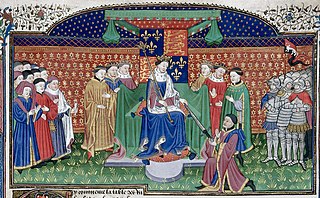Related Research Articles

Pandulf Verraccio, whose first name may also be spelled Pandolph or Pandulph, was a Roman ecclesiastical politician, papal legate to England and bishop of Norwich. Pandulf was born in Rome, and first came to England in 1211, when he was commissioned by Innocent III to negotiate with King John. He is often erroneously called Cardinal Pandulph or Pandulph Masca due to being confused with Cardinal Pandolfo da Lucca, who himself was confused with Cardinal Pandulf of Pisa and erroneously given the Pisan family name Masca. His authentic surname may be rendered Verraccio, Verracchio or Verracclo.

Robert Hallam was an English churchman, Bishop of Salisbury and English representative at the Council of Constance. He was Chancellor of the University of Oxford from 1403 to 1405.

John Stafford was a medieval English prelate and statesman who served as Lord Chancellor (1432–1450) and as Archbishop of Canterbury (1443–1452).

Richard Poore or Poor was a medieval English Bishop best known for his role in the establishment of Salisbury Cathedral and the City of Salisbury, moved from the nearby fortress of Old Sarum. He served as Bishop of Chichester, Bishop of Salisbury and Bishop of Durham.
Philip de Harcourt was a medieval Lord Chancellor of England and Bishop of Bayeux. He was unsuccessfully elected as the Bishop of Salisbury.
William Alnwick was an English Catholic clergyman. He was Bishop of Norwich (1426–1436) and Bishop of Lincoln (1436–1449).
Richard of Ilchester was a medieval English statesman and prelate.
Richard Courtenay was an English prelate and university chancellor, who served as Bishop of Norwich 1413-15.
Herbert Poore or Poor (died 1217) was a medieval English clergyman who held the post of Bishop of Salisbury during the reigns of Richard I and John.
Thomas Brunce was a 15th-century Bishop of Rochester and then Bishop of Norwich.
The Bishop of Salisbury is the ordinary of the Church of England's Diocese of Salisbury in the Province of Canterbury. The diocese covers much of the counties of Wiltshire and Dorset. The see is in the City of Salisbury where the bishop's seat is located at the Cathedral Church of the Blessed Virgin Mary. The current bishop is Nick Holtam, the 78th Bishop of Salisbury, who was consecrated at St Paul's Cathedral on 22 July 2011 and enthroned in Salisbury Cathedral on 15 October 2011.
Geoffrey de Burgh was a medieval Bishop of Ely.
Adam Moleyns was an English bishop, lawyer, royal administrator and diplomat. During the minority of Henry VI of England, he was clerk of the ruling council of the Regent.
Everard was a medieval Bishop of Norwich.
Simon of Elmham was a medieval Bishop-elect of Norwich.
Simon Walton was a British clergyman who served as the Bishop of Norwich.
John Salmon was a medieval Bishop of Norwich.
Gilbert Glanvill or Gilbert de Glanville was a medieval Bishop of Rochester.
Henry Brandeston was a medieval Bishop of Salisbury.

Simon of Ghent was a medieval Bishop of Salisbury in England.
References
- British History Online Bishops of Norwich accessed on 29 October 2007
- British History Online Deans of Salisbury accessed on 29 October 2007
- Fryde, E. B.; Greenway, D. E.; Porter, S.; Roy, I. (1996). Handbook of British Chronology (Third revised ed.). Cambridge: Cambridge University Press. ISBN 0-521-56350-X.
| Catholic Church titles | ||
|---|---|---|
| Preceded by William de Turbeville | Bishop of Norwich 1175–1200 | Succeeded by John de Gray |